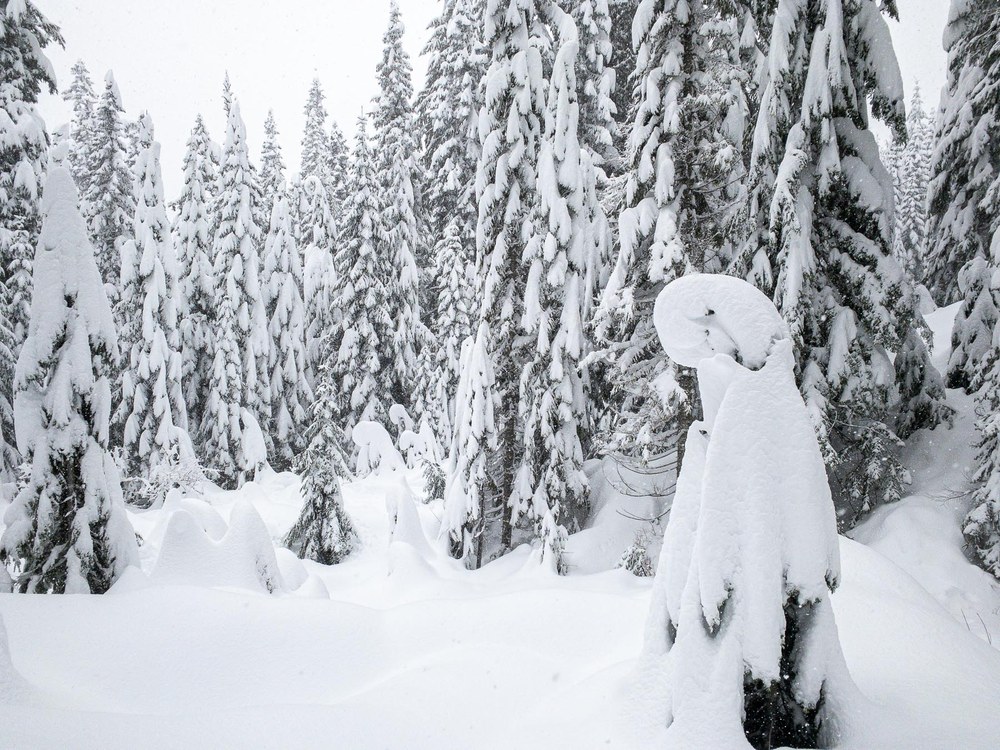
"Oh, good," said Steve, our instructor, "now you can practice getting up after a fall."
He was standing just behind me, adjusting his gear after he'd had to climb out of a pit. My right leg had just sunk into the snow, all the way to my waist. My left knee had buckled over, and I was awkwardly lying and standing in deep snow.
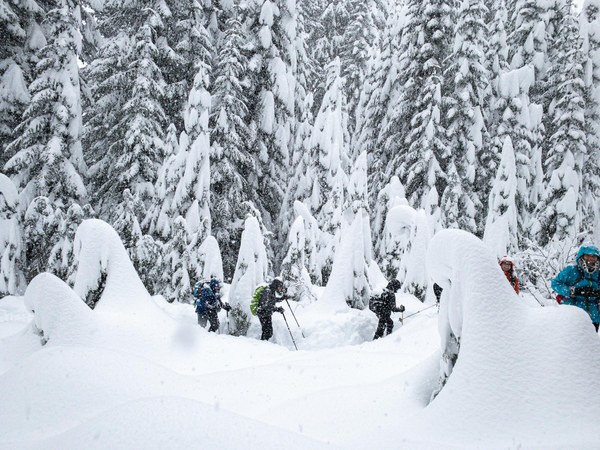 The snow fell in large flakes building the base as we hiked into Commonwealth Basin. The trees were draped in a thick layer of white. It was a magical setting for our class.
The snow fell in large flakes building the base as we hiked into Commonwealth Basin. The trees were draped in a thick layer of white. It was a magical setting for our class.
Steve was not being sarcastic or nasty. He had said before we left the parking lot that everyone needed to practice falling and getting up. Figuring out how to stand back up on snowshoes was an essential skill that we all needed to master.
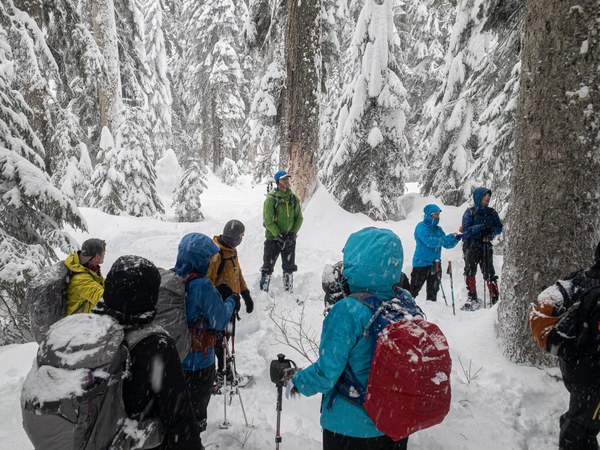 So much to learn and what better setting than in the middle of the wilderness with snow falling all around. Old-growth Pacific silver firs and western hemlocks towered over our classroom, and occasionally snow bombs dropped from upper branches.
So much to learn and what better setting than in the middle of the wilderness with snow falling all around. Old-growth Pacific silver firs and western hemlocks towered over our classroom, and occasionally snow bombs dropped from upper branches.
Eighteen of us met our four instructors early in the morning for our field trip, a critical part of our Basic Snowshoeing Course. When I fell, we'd been in the woods for four hours, traveling a loop into the Commonwealth Basin at Snoqualmie Pass. Each of us had a chance to lead the way, cutting a fresh trail through knee-deep powder. Large snowflakes had been falling all morning, and the accumulation probably topped an inch per hour. People’s hats consistently had a half-inch of snow on them, and when we stopped for lunch, my backpack became white in just the time it took to down a sandwich.
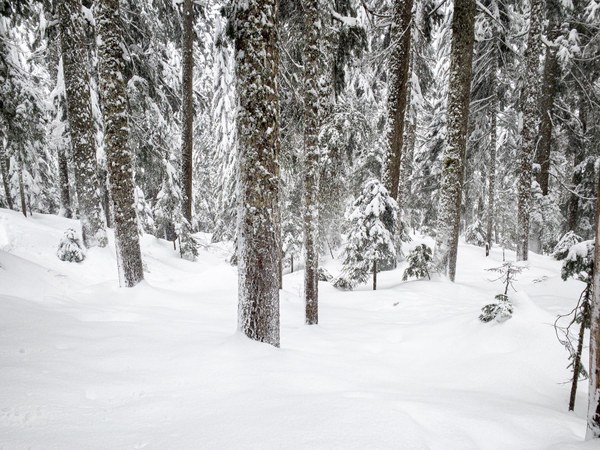 The snow base was thick and covered much of the understory topography in an undulating sea of white.
The snow base was thick and covered much of the understory topography in an undulating sea of white.
Snow blanketed the Pacific firs and western hemlocks in this old-growth forest. The falling flakes blurred everything, creating a mystical and enchanting setting. Snow bombs would suddenly release from upper branches and come down in a booming thunder of white, creating a cloud that radiated out in all directions, engulfing us and causing us to hunch over in an attempt to minimize the snow entering our necks. The forest took on an abstract design, artistic. It was magical.
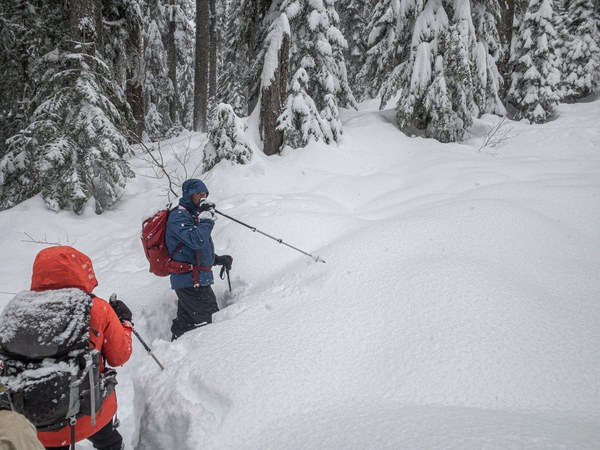 “Do you expect me to go that way?” The powder was knee to thigh deep and created a challenging experience to lead the way. We all had a chance to experience that task and learned quickly to appreciate the one in the lead.
“Do you expect me to go that way?” The powder was knee to thigh deep and created a challenging experience to lead the way. We all had a chance to experience that task and learned quickly to appreciate the one in the lead.
Many times, I’d held up the procession as I gawked at the forest. Undulating white rolled over the landscape, forming mounds that concealed bushes, stumps, or logs. Conifer branches held an inch or more of snow, obscuring the needles, making me look closely to see which species it might be. Even the bark on massive trees had white flakes clinging to it, giving a subtle cast to the dormant lichens and mosses.
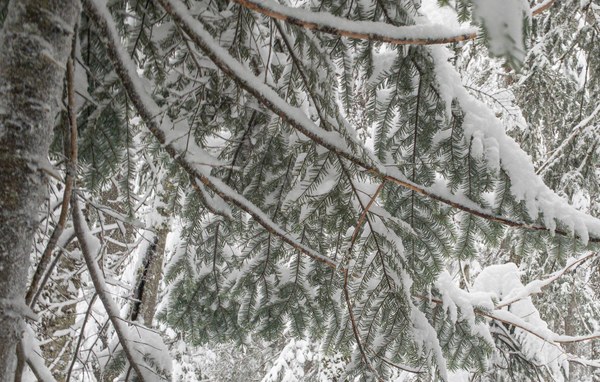 The underside of a Pacific silver fir branch creates a beautiful design in the winter landscape.
The underside of a Pacific silver fir branch creates a beautiful design in the winter landscape.
Once, I stopped to stare at the underside of a Pacific silver fir. The snow made the needles look like a thatched roof that protected a dwelling underneath. The flat outstretched nature of them was accentuated, and the needles that ran along the top of the twig seemed to grasp the snow. No wonder these conifers hold the white powder, creating tree wells that we had been warned about several times in the class.
It was one of those wells under a small bush that had captured me. Nineteen people had passed this narrow place and not fallen, but the side gave way as I came by. My right leg had sunk close to three feet, all in slow motion, and the snow-filled in behind me. My snowshoe was strapped tight to my foot and held what seemed like an impossible load on top of it. My foot tried to twist and turn but could move only an inch or two.
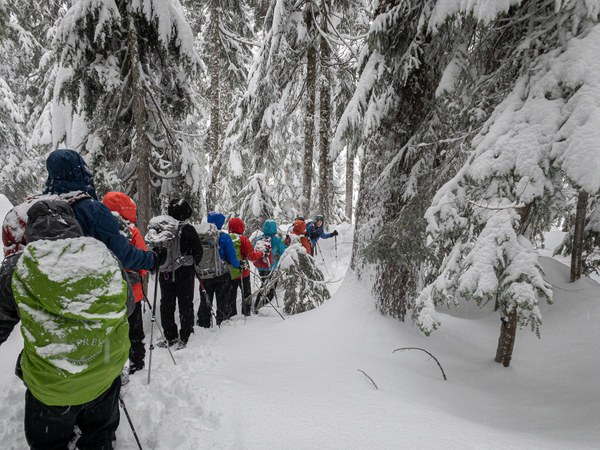 “This way, you think?” Deep snow made the trails undetectable. Navigation became critical and keeping together essential.
“This way, you think?” Deep snow made the trails undetectable. Navigation became critical and keeping together essential.
Barbara asked Steve, “Should we help him.”
“Na, he needs to learn how to get out,” replied Steve.
I jabbed at the snow with my pole, twisted and heaved on my leg, seeming to make slow progress, finally rolling out onto the packed path.
“Now, use your poles in an X and get first up on one leg,” said Steve. I felt like the performer in a mud wrestling exhibition, only I was tussling with myself and now all covered in white.
Finally, I came to my feet, adjusted my pack, and starting down the trail. "Thanks," I said to the two behind me. This was what I'd signed up for and now felt more confident that exploring wilderness in winter was doable.
 Thomas Bancroft
Thomas Bancroft
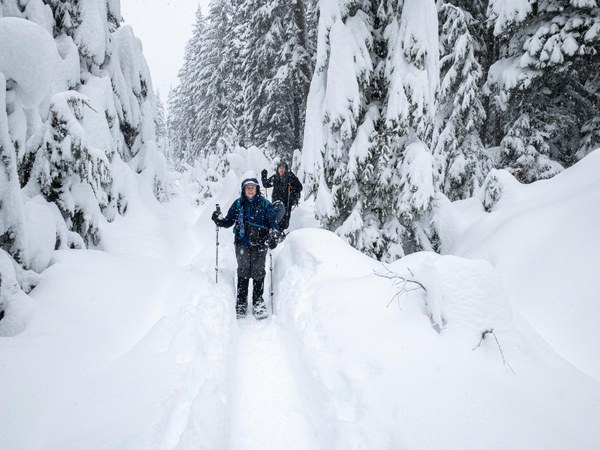 Volunteer leaders and instructors create the opportunity for the rest of us to learn. Two of the four leaders on this hike brought up the rear and made sure we were all safe and having fun. Thank you!
Volunteer leaders and instructors create the opportunity for the rest of us to learn. Two of the four leaders on this hike brought up the rear and made sure we were all safe and having fun. Thank you!